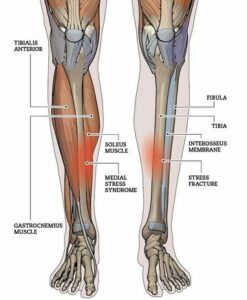A 55-year-old female triathlete presents to their Physiotherapist with right shin pain during activity. She had been diagnosed previously by her primary care physician with Medial Tibial Stress Syndrome. The patient was referred to a Canadian Certified Pedorthist for evaluation and treatment. https://pedorthic.ca/find-a-pedorthist/

The Pedorthist conducts an extensive history and assessment, including a range of motion testing, gait analysis, and footwear evaluation. The Pedorthist finds:
- ROM/Non-Weight Bearing Evaluation
- Talocrural joint dorsiflexion restricted bilateral (<10 degrees of dorsiflexion)
- Excessive subtalar joint eversion, R>L
- All other range of motion was within normal limits at the foot/ankle
- Weight Bearing Evaluation
- Bilateral Pes Planus foot type
- Rearfoot eversion, R>L
- Tibial varum bilateral
- Gait analysis
- Normal lateral heel strike
- R>L subtalar joint overpronates during midstance, causing excessive medial rotation through the tibia and subsequent strain to the tibialis anterior muscle/tendon.
- Propulsion and swing phase normal
- Current Footwear Evaluation
- Running Shoes for triathlons are appropriate for the foot type and are in good condition.
- Wearing a neutral cushioned running shoe with torsional stability and a solid heel counter
- She wore flip-flops into her appointment and reported that’s what she wears on a daily basis; these are not providing adequate support.
- Does not wear footwear in the house.
- Running Shoes for triathlons are appropriate for the foot type and are in good condition.
The Pedorthist educates the patient on their findings and the importance of Footcare/Foot health.
The Pedorthist treats with:
- Custom-made orthotics fabricated from a 3D casting
https://www.pedorthic.ca/insurance-providers/casting/
- Semi-rigid functional orthotic to provide a combination of structure and cushion for shock absorption due to activity level
- Right medial rearfoot post to support subtalar joint position and reduce rotational force through the right tibia when running
- Footwear education
- Advised to wear proper footwear at home that can accommodate her orthotics so that she can continue to recover when she is not running
- Recommended a slipper with a stiff sole and a removable footbed
- Advised to wear supportive footwear for her day-to-day lifestyle and to transfer her orthotics into this footwear
- Flip flops were advised against
- A casual shoe or athletic shoe with torsional stability through the midfoot and a solid heel counter advised
- The current footwear selection for running is appropriate
- Advised to ensure footwear is replaced every 500km of running
- Referrals to other health professionals
- Currently seeing a physiotherapist for therapeutic modalities and stretching/strengthening.
- Recommended she could see a Registered Massage Therapist for treatment after her races
- Advised to wear proper footwear at home that can accommodate her orthotics so that she can continue to recover when she is not running
